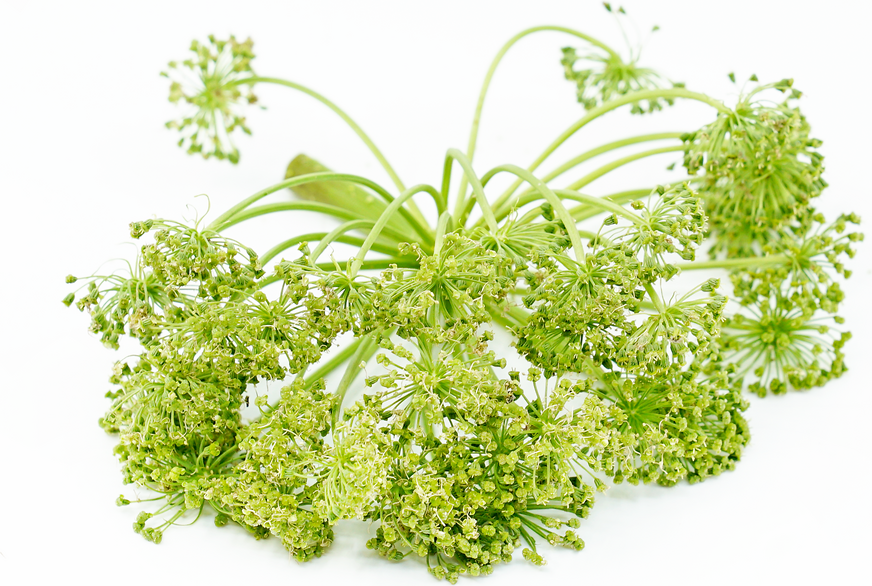


Angelica Flowers
Estimated Inventory, 50 ct : 0
This item was last sold on : 07/14/24
| Fresh Origins | Homepage |
Description/Taste
Angelica flowers are small blossoms arranged in an umbel formation that resembles a pompom. Each cluster of flowers extends from a long and skinny green hollow stem, with multiple umbels attached to a thicker, cylindrical hollow stem. The flowers are mostly white but can appear yellow or green before they open. Angelica flowers have a distinct and pleasant aroma with notes of juniper, anise, and musky undertones. The flowers have a pungent flavor with herbaceous notes of sweet anise.
Seasons/Availability
Angelica flowers are in season from the spring through early summer.
Current Facts
Angelica flowers are the blossoms of over 60 different varieties of perennial herbs classified under the genus Angelica. Angelica is a member of the Apiaceae family, a family of umbellifers that include carrots, celery, coriander, dill, fennel, and parsley. This herb is also known as Wild Celery or Garden Angelica and is cultivated for both ornamental and culinary uses. While all varieties of Angelica are entirely edible from root to flower, California Angelica is the variety most favored for their flowers, which can be found growing wild in northern California and southern Oregon. Angelica flowers should be picked early in the season for optimal flavor and can be used to garnish a variety of dishes, adding a unique aroma, taste, and texture. They can also be added to beverages and infusions or used in perfumes and potpourri.
Nutritional Value
Angelica flowers are a significant source of vitamin C, a vital nutrient that strengthens the immune system, and potassium, a mineral that helps regulate fluids in the body, muscle contractions, and nerve signals. The flowers also have antifungal, antibacterial, and blood-thinning properties, making them useful as an anticoagulant. Angelica has been used for centuries to help treat sore throats, mouth ulcers, and bronchitis.
Applications
Angelica flowers are best consumed raw and can be tossed into salads, floated atop soups and curries, added to fruit bowls, or used to garnish fish, poultry, and pork dishes. The flowers perfectly balance dishes featuring acidic fruits like rhubarb, orange, and lemon as the sweet anise flavor reduces acidity. Their delicate appearance also makes the perfect garnish for cakes, cookies, scones, and sorbets, as well as cocktails featuring licorice flavored spirits like Chartreuse and Vermouth. Angelica flowers pair well with poultry, seafood, and pork, as well as with other spring vegetables like asparagus, peas, rhubarb, and wild mushrooms, fruits like apples and citrus, and fresh herbs like basil, tarragon, and chervil. The flowers should be used immediately for best quality and flavor and will keep 1 to 2 days when stored in a sealed container in the refrigerator.
Ethnic/Cultural Info
Angelica has been used for centuries in the production of old-world tonics and liqueurs, including Chartreuse, Vermouth, and Benedictine, and modern-day bartenders, mixologists, and home distilling enthusiasts are tapping into these ancient recipes to create their own complex spirits. Prized for their robust herbaceous aromas and tastes, anise-flavored liqueurs have gained popularity as the demand for unique and inventive cocktails has increased. Angelica flowers can be infused into spirits or bitters, fermented to create a botanical liqueur, or used as the perfect garnish to complete a well-balanced licorice cocktail.
Geography/History
Angelica is believed to be native to Syria and was used for medicinal and ritual purposes in the region for thousands of years. The herb spread along trade routes throughout Europe, Greenland, Iceland, Western Siberia, the Himalayas, and into China. The plant was brought to the New World with colonists in the early 15th century, where it was grown in gardens before eventually naturalizing along the west coast. Today, Angelica is cultivated in temperate and cool regions worldwide and can be found growing wild in dry, low-elevation slopes of foothill and coastal ranges. The flowers are typically sold through farmers markets and specialty stores when in season.




 Learn More...
Learn More...
